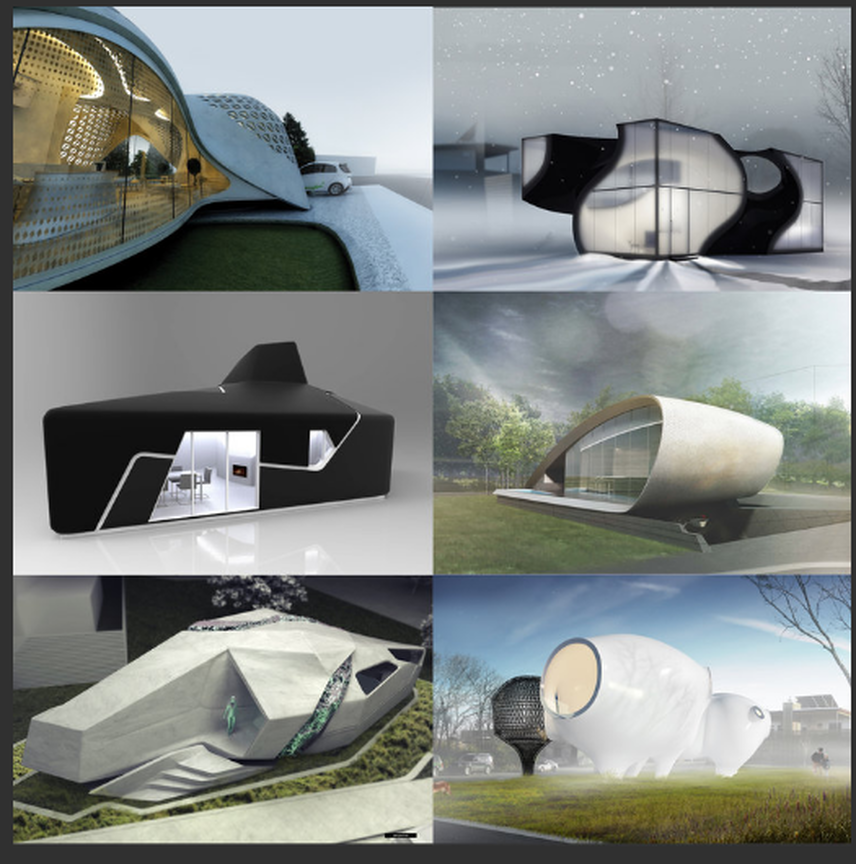|
Gaurav Das (Product Development Engineer/New Business) and Chief Scientific Editor
Bob Talling (Managing Director) and Chief Executive Officer Contact: [email protected] The Vision In the near future our buildings can look very different than it looks now and made of very different materials. Figure 1: 3-D printed building designs
Be it a hot and humid region or cold climate, technologies and products are being made to supply the needs of this emerging trend.
What is 3-D Printing? In really simple terms, its about printing objects using an ink, printer and fabrication design. 3-D printing has been used in many industries such as biomedical (tooth, limb etc), materials engineering (alloys), plastics etc. For the construction industry the ink is cementous materials with suitable setting times. These Cementous materials or binders could be Portland cement like materials, exotic geopolymers and industrial side-stream based hybrids. In case of construction industry it is also becoming a trend with huge government backing and megaprojects in UAE, Saudi Arabia, USA, Europe etc. Why 3-D Print your building? With the rise of circular economy, resource conservation and strict carbon emission legislations 3-D printable building materials are the future. The model below depicts this quite well. Figure 2: 5 reasons to 3-D print your building
As you can see there is significant incentives to apply 3-D printable concrete in construction of houses and buildings. The idea of custom design is highly appealing to many people. This allows them to truly express their personality in their living space. With 3-D printers which are pre-programmed with the design will make it a reality. It will not be surprising to see building which are just boxes stacked on each other. Our current choices are quite limited in this regard and customers have limited innovative offering. Now to make unique designs possible one needs the right kind of novel construction materials.
These “novel” materials are the heart of this new paradigm shift. We at Renotech are pioneers and international experts in this area. These novel materials are innovative, cheap and eco-friendly. The advancement of automation technology has provided the tools to create such printable structures. There are different methods to print and the most commonly established is the layer by layer technique. Other methods involve drone printing and printer on railways. This has reduced construction time and cost drastically. As per recent news from Dubai, the local government wants to have 25% of buildings 3-D printed by 2030 with the target for 2019 being 2%. Similar accounts suggest they expect 90% reduction in cost. European companies propose to rebuild the Notre Dame in Paris using ash, burnt stones etc. The construction involves the use of 3-D printing of structures for high level precision and accuracy. Use of “novel” materials which are cheap, eco-friendly and flexible provides a key advantage compared to traditional Portland based cements. This advantage being additional revenue generation for the building owners in terms of carbon credits, tax subsidies etc. New business models? YES In the future new business model will involve using novel materials for construction, novel design to maximise free light, energy, air exposure. Renting out a house will be more than just money from tenant but also carbon credits, data sharing, water and electricity self sufficiency etc. Some of these are already happening but in isolation hence its only a matter of time until they are efficiently integrated in a single package. We believe that circular economy and emission related legislation in Finland and EU will open up many new opportunities hence new business models will be created. Eg: Our Ash2Cash initiative has been successful where we valorize ash for applications in wide range of construction activities. Current legislation has already banned dumping of certain ashes and industrial wastes in landfills. We at Renotech are playing a leading role in circular economy solutions in Europe. We wish to be the leader in the newly emerging field of 3-D building materials especially in Finland. The revolution has already started, just look at the examples below. Conventional construction versus 3-D printing
In our Part 2 bulletin we shall discuss how circular economy plays a key role to address the unique needs. For the full report, joint projects or consulting work contact Bob Talling [email protected] , for questions related to the article contact [email protected] The article is mainly meant for educational purposes.
2 Comments
Leave a Reply. |
|
Renotech Oy
TURKU, FINLAND VAT reg. nr. FI09674124 |
Open hours:
Loading and unloading Mon-Fri 07.30–15.30 – Click here for exceptions. Office hours: Mon-Fri 08.00–16.00 – Click here for exceptions. |
Follow us on social media
|
©
Renotech Oy






